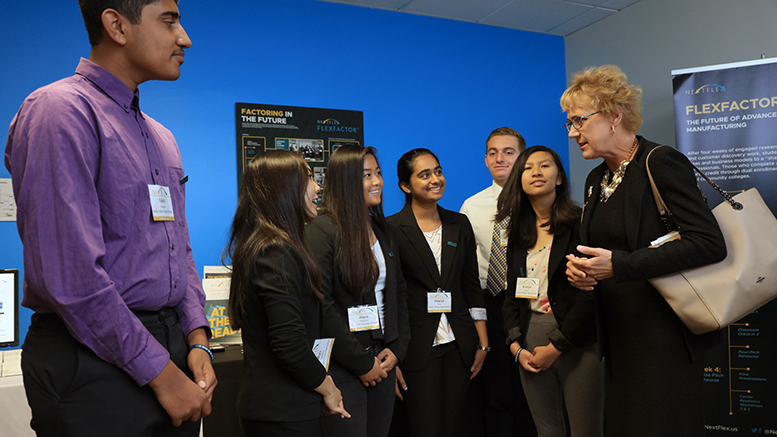Blue-collar industries in the U.S. are facing a massive skills shortage.
The National Association of Manufacturers predicts 2 million job vacancies nationwide by 2025, while the American Welding Society forecasts a shortfall of 300,000 welders and welding instructors in the manufacturing industry by 2020.
Community colleges are attempting to bridge America’s widening blue-collar skills gap through workforce development programs promising living-wage jobs that don’t require four years of college. While trade, construction and manufacturing companies are starving for talented workers, these fields also suffer from an image problem, one fueled by societal stigmas of low wages, dirty conditions and backbreaking labor.
Overcoming such stereotypes is part of the package for two-year colleges marketing their workforce programming to potential participants.
Getting the word out
Eastern West Virginia Community and Technical College is one college pushing against beliefs that the only path to a rewarding career is a four-year college degree and a “glamorous” job in finance, law or engineering.
Eastern’s 75-hour welding training course accommodates all experience levels, introducing learners to basic welding processes and cutting operations, with higher level classes teaching advanced methods for application on different types of metals.
The four-level course is tailored to each student’s skill set, preparing them for the performance-based American Welding Society (AWS) equivalency and a future in a lucrative job market.
“We provide a certificate of completion whether or not students take the equivalency exam,” says program director Melissa Shockey. ‘The exam shows local employers that this student is coming out with a level of expected welding skills to be a technician. It gives them a leg up when applying for work.”
This excerpt comes from the current issue of the American Association of Community Colleges’ Community College Journal.
Those entering the welding workforce start with an average salary between $12 to $28 an hour, program organizers say. However, certified welders have an opportunity to advance onto foreman or even superintendent positions. Eastern also has an agreement with a local Iron Workers union where individuals credentialed through the AWS equivalency — in combination with another 10 hours of training from the Occupational Safety and Health Administration (OSHA) — receive up to two years off their journeyman welder training requirements.
“Students find jobs with different manufacturers, in the automotive industry or with power plants,” says Briana LaVorgna, dean of community engagement at Eastern. “Basically, any employer that has a welding position open — it just varies by industry.”
Eastern’s welding classes run for 10 weeks per level and have become popular enough to require a waiting list. Each course averages about a dozen students, predominately men ranging from age 20 to 40. Many arrive with no welding background, or want a career change after getting laid off from another industry. The program also attempts to attract women jobseekers, an in-demand demographic that is mostly underrepresented in the manufacturing industry.
Eastern’s outreach efforts in these areas include debunking manufacturing myths of being dangerous, dead-end jobs for people with no other employment options. The college hired community college marketing firm 25th Hour Communications to create print and social media ads that champion welding as a well-paying career, not just a stop-gap job. Marketing materials emphasize a rapid training-to-workforce pathway where both men and women can obtain profitable employment outside of the four-year college system.
Future ads will showcase manufacturing floors as clean, brightly lit and up to the latest safety standards.
Program proponents also spearhead regional meetings to speak with employers on their hiring needs, and put accredited students on a registry list for interested companies to peruse.
“The stigma (about blue-collar work) has done all the skill trades a disservice,” LaVorgna says. “But young folks joining the trades are creating a wonderful life in clean jobs that pay well. It’s about getting the word out there, fighting stereotypes and promoting good, high-paying jobs here at home. Our demographic wants to live here, work here and provide for their families.”
Clearing up cloudy optics
A program out of California seeks to introduce young people to manufacturing even before they graduate high school. Flex Factor is a dual-enrollment advanced manufacturing initiative that has grown from eight students to more than 2,000 in the 12 months since it was introduced.
Evergreen Valley College (EVC) partnered with Flex Factor designer NextFlex to introduce high school learners to the world of flexible hybrid electronics (FHE) by way of an in-class entrepreneurship project. During its first iteration last year at Lincoln High School in San Jose, students from Lincoln’s Capstone Course worked in teams — guided by a NextFlex mentor — to develop a business model integrating FHE into an advanced manufactured healthcare or performance-monitoring device.
Over the length of the five-week program, participants presented ideas for a drug test patch and an injury monitoring tape. Their journey included a tour of manufacturing giant Jabil, as well as visits to EVC’s campus and NextFlex’s headquarters.
“Students are learning how to build a product, how much it costs, what customers they should target, and anything else dealing with product development from inception to launch,” says Lena Tran, dean of business and workforce development at EVC. “This program is getting younger generations excited about nontraditional manufacturing by letting them build cool products.”
Flex Factor is currently active in 50 classrooms in six Santa Clara County school districts, with plans to expand out of state should the initiative’s current popularity continue.
Read the full article online.

